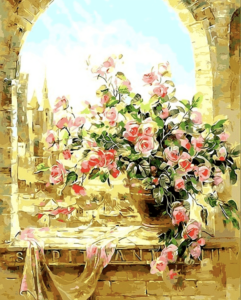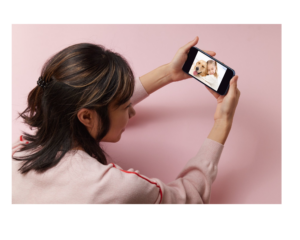Are you a painting beginner? Are you ready to start your painting journey, but are unsure of how and where to start? Well, we here at Just Paint By Number have you covered! We’ve got plenty of painting for beginners tips and tricks to help get you started.
We only have one unwavering rule: you have to have fun whilst you learn! The more you enjoy the creative process, the better your paintings will turn out. Learning painting shouldn’t be a chore, it’s a pastime you should relish.
So if you’re up for the exciting challenge and want to know how to start painting as a hobby on your own, we have all the painting basics you need to know. Let’s begin our painting for dummies guide!
Tip #1: Pick the right medium to start with
First things first, you should pick the right medium to start with. There are 3 main painting mediums beginners usually choose from:
Acrylics
Acrylic paints are fast-drying and can be used on almost any surface, including standard paper and canvas sheets. It’s also water-soluble, so it’s easy for you to thin and water down if you find the paint too thick. Best of all, acrylic paints are cheap, versatile, and easy to clean up!
Oils
Oil paints are a super popular medium, simply because they have a slower drying time. This gives you more leeway to blend and play around with your colors and brushstrokes. Some beginners assume working with complex oil paints is too advanced for newbies, but that’s not the case!
Watercolors
Although watercolors are often considered the most difficult medium for beginners, the payoff can be marvelous once you master the techniques. Best of all, watercolors can produce stunning results if you know how to deal with the fast-absorbing consistency.
So what paint medium is best for beginners?
Usually beginners start with acrylics and then dabble with oils and watercolors once they’ve learned the painting basics. However, we suggest experimenting with all 3 to get familiar with how each of them differs. Find what medium you personally prefer and what one provides the results you love most.
Tip #2: Invest in high-quality materials
Investing in high-quality painting materials is a basic painting rule. Budget paints with a cheaper price tag will leave you with murkier or duller results, and we don’t want you being put off by something out of your own control. So find quality paints that have higher pigment loads. You’ll notice that your paintings look brighter and cleaner!
Here’s a typical painting for beginners list of all the things you need to get started:
- Combination of paints (it might be worth starting with just the primary colors to help you learn how to mix).
- Brushes (a good few options that are suitable for your medium).
- Palette (for mixing your colors).
- Easel (for holding your ‘in progress’ artwork in place).
- Canvas (for acrylics or oils) or paper (for watercolors).
Tip #3: Don’t put any pressure on yourself
Knowing how to start painting isn’t easy. So take the pressure off yourself. Don’t expect to become the next big thing overnight. It takes time to learn basic painting techniques, so be patient and practice regularly (preferably daily!). Slow and steady certainly wins the prize when it comes to painting.
If you find you’re not a natural, you can always try paint by numbers first. We have a huge selection of wonderfully themed kits for you to experiment with if you’re unsure of where and how to start. Browse our collection today!
Tip #4: Learn the painting fundamentals
Just like any hobby, there’s painting basics and fundamentals you need to know. No one expects any beginner painting to be an absolute masterpiece. There’s a lot you need to learn and practice beforehand! Here’s 3 fundamentals you should focus on when learning how to start painting:
Mix your colors
Don’t shy away from color mixing because this will help you understand the importance of tints, tones, and shades. Learn the basics of color theory and experiment with different colors whenever you can.
Master different brushstrokes
You’ll notice that different brushstrokes will create different effects depending on the medium that you use. The type of brushwork you use will depend on the sizes and types of brushes you use too. You might even choose to work a palette knife or even your finger eventually.
Think about composition
Painting composition isn’t as complex as you think. It’s simply the way in which you want to show the object you’re painting. Composition includes thinking about all types of different visual elements that make up your illustration, including angles, perspectives, shapes, lines, space, and depth. It’s all about making sure everything is in its right place.
Tip #5: Review and improve upon your first painting
After finishing your first painting, take the time to reflect on what you like and dislike about it. Even the world’s most renowned professional artists are still learning, so don’t be too critical! Think about what went wrong and what went right with the painting, and most importantly, how you can improve upon its flaws with the next one.
Tip #6: Trust your own creativity
Don’t be put off by other artists’ work or feel intimidated by a painting that’s better than yours. Just look to it for inspiration and learn from their success. It might be worth studying the history of art too. That way you’ll gain knowledge on how certain techniques and methods first came about from the painting masters who came before us.
Remember: Painting for beginners isn’t about finding your own unique style right away. It could take years to find your own distinct selling point. Instead, you should simply trust your own creativity and be open-minded when it comes to trying out new ideas and techniques.
If you’re out of ideas, we have 4 big ideas for your next project. Sometimes creativity comes when you get back to basics.
Tip #7: Set your own personal goals
Last but not least, set some personal goals that you want to achieve. Once you’ve learned the basics of the painting process and know what methods you feel most comfortable with, it’s time to bring your visions to life.
Embrace your mistakes and celebrate your successes. You’re always your own worst critic, but don’t be too harsh on your creations. The more you recognize your own triumphs, the more you’ll feel motivated to pick up the paintbrush once again and carry on learning.
Feel inspired with Just Paint By Numbers!
Our painting for beginners tips will not only help you improve upon your skills, but they should encourage you to relax and enjoy the learning process along the way.
So now you know how to start painting, why not browse our collection of paint by number kits? We stock over 300 designs, so we’re sure there’s something for any beginner painting enthusiast out there!
Best of all, we offer free worldwide shipping and 60 days of money-back guarantee. Your 100% satisfaction is our absolute priority.
Get in touch with our friendly team today if you have any questions about painting basics or fundamentals. Alternatively, you can look at our FAQs page.






2 comments
Hi,
This may be the encouragement that I need to start learning how to paint.
Despite no painting experience I like texture and color and now am in Covid isolation.
Suggestions please.
Thanks
Thanks, Fay. We would suggest starting with paintings that have larger areas with less detail to start for your first one!